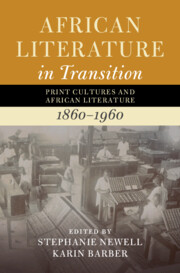Book contents
- African Literature in Transition
- African Literature in Transition
- African Literature in Transition
- Copyright page
- Contents
- Figures
- Tables
- Contributors
- Introduction
- Part I Producing Print
- Part II Readers and Audiences
- Part III New Genres
- Part IV Worlds of Print
- Chapter 17 Double-Sided Print
- Chapter 18 Between the Railway and the Minaret
- Chapter 19 Making Audiences
- Chapter 20 Print and the Question of Literature in Islamic West Africa
- Chapter 21 Print Networks in the Black Atlantic World, c. 1920–1960
- Chapter 22 ‘A curious creature from the market’
- Index
- References
Chapter 19 - Making Audiences
Gäbrä-Əgziabher Gila-Maryam as a Forerunner of Ethiopian Print Culture, 1895–1914
from Part IV - Worlds of Print
Published online by Cambridge University Press: 23 October 2025
- African Literature in Transition
- African Literature in Transition
- African Literature in Transition
- Copyright page
- Contents
- Figures
- Tables
- Contributors
- Introduction
- Part I Producing Print
- Part II Readers and Audiences
- Part III New Genres
- Part IV Worlds of Print
- Chapter 17 Double-Sided Print
- Chapter 18 Between the Railway and the Minaret
- Chapter 19 Making Audiences
- Chapter 20 Print and the Question of Literature in Islamic West Africa
- Chapter 21 Print Networks in the Black Atlantic World, c. 1920–1960
- Chapter 22 ‘A curious creature from the market’
- Index
- References
Summary
This chapter analyses the epistemological overhaul of genres and ideas of textuality that took place in Ethiopia between the end of the nineteenth century and the beginning of the twentieth, and that prepared the grounds for the rise of Amharic print culture. Gäbrä-Əgziabher Gila-Maryam is generally credited with producing the first Amharic newspaper. His poetic newssheets readapted the genre of the awaj, or imperial proclamation. Most of these newssheets were handwritten, but Gäbrä-Əgziabher also pioneered the use of print to clandestinely circulate a longer type of awaj in prose. Through an analysis of Gäbrä-Əgziabher’s genre innovations, the chapter argues that the emergence of print in Ethiopia should be understood as part of a broader transformation of the oral/written interface – itself a result of the resignification of notions of ‘the public’ in the context of the new global dimension of politics.
Keywords
Information
- Type
- Chapter
- Information
- African Literature in TransitionPrint Cultures and African Literature, 1860–1960, pp. 374 - 391Publisher: Cambridge University PressPrint publication year: 2025
References
Accessibility standard: Inaccessible, or known limited accessibility
Why this information is here
This section outlines the accessibility features of this content - including support for screen readers, full keyboard navigation and high-contrast display options. This may not be relevant for you.Accessibility Information
Content Navigation
Allows you to navigate directly to chapters, sections, or non‐text items through a linked table of contents, reducing the need for extensive scrolling.
Provides an interactive index, letting you go straight to where a term or subject appears in the text without manual searching.
Reading Order & Textual Equivalents
You will encounter all content (including footnotes, captions, etc.) in a clear, sequential flow, making it easier to follow with assistive tools like screen readers.
You get concise descriptions (for images, charts, or media clips), ensuring you do not miss crucial information when visual or audio elements are not accessible.
You get more than just short alt text: you have comprehensive text equivalents, transcripts, captions, or audio descriptions for substantial non‐text content, which is especially helpful for complex visuals or multimedia.
Visual Accessibility
You will still understand key ideas or prompts without relying solely on colour, which is especially helpful if you have colour vision deficiencies.
You benefit from high‐contrast text, which improves legibility if you have low vision or if you are reading in less‐than‐ideal lighting conditions.
